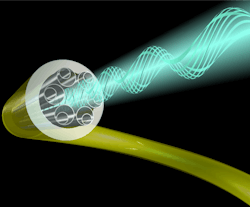Hollow-core optical fibers made to transmit at 600 to 1100 nm have achieved losses lower than solid-core fibers at those wavelengths. It’s an important first because losses of the best solid-core silica fibers are high enough to limit performance in applications including laser power delivery, biophotonics, short-haul communications, and potentially quantum communications. The new hollow-core fibers were made at the University of Southampton’s Optical Research Centre (Southampton, England) and its commercial spinoff Lumenisity (Romsey, England).1
The new fibers are based on the same nested antiresonant nodeless fiber (NANF) design that Southampton used in 2020 to demonstrate a record-low loss of 0.28 dB/km for a hollow-core fiber at the 1550-nm telecommunications band.2 That loss was less than half the previous hollow-core fiber record of 0.62 dB/km reported in 2019.3 However, solid-core fiber retains the record low loss at 1550 nm with 0.142 dB/km.4
Pure silica absorbs virtually no light from visible wavelengths out to about 1500 nm, but Rayleigh scattering dominates loss of transmission at wavelengths shorter than 1550 nm. Rayleigh scattering in silica increases with the inverse fourth power of wavelength. To minimize this scattering, the NANF fiber is designed to trap light in the central hollow core of the fiber (see figure). Six parallel nested pairs of hollow tubes line the outer edge of the core, displaying negative curvature, which blocks light from reaching the core edge. Leaving space between the edges also helps confine light within the hollow core, so very little of the light is coupled into the silica where it could be scattered to cause attenuation.
The Rayleigh scattering coefficient of a glass is proportional to the temperature at which it solidifies and freezes density fluctuations in place, so it is high for silica with its high melting point. In theory, chalcogenide and multicomponent heavy-metal-halide glasses should have much lower Rayleigh scattering because of their low softening temperatures, but so far that has not been attainable experimentally, leaving pure silica the best choice for fibers at wavelengths between 300 and 1700 nm.
To see how well hollow-core fibers could perform, the Southampton group designed and fabricated lengths of hollow-core fiber for three key short-wavelength bands: 600–730 nm, 720–950 nm, and 1000–1200 nm. They measured losses of the hollow-core fibers at important wavelengths for all three bands and compared them with Rayleigh scattering in silica. At 660 nm, the hollow-core fiber had loss of 2.85 dB/km, compared to Rayleigh scattering alone of 4 to 5 dB/km. At 864 nm, close to the 850 nm short-distance communication band, they measured 1.4 dB/km compared to 1.3–2 dB/km for Rayleigh scattering. For the 1064 nm line often used on laser machining, they measured loss of 0.52 dB/km compared to 0.6–0.8 dB/km for Rayleigh scattering in silica. All three fibers have 3 dB bandwidths over 130 nm.
“The first commercial application of NANF fibers has already happened,” says Southampton group leader Francesco Poletti. The immediate allure of hollow-fiber cables is the low latency that comes from transmitting light at 99.9% its speed in vacuum, a 50% increase over the 66% vacuum speed in silica. High-frequency security trading is a near-term use, but 5G networks and data-center transfers also require low latency. Reducing loss at 850 nm to below 0.5 dB/km and taking advantage of the large mode-field diameter and low dispersion of hollow-core fibers could increase the bandwidth-distance product of short-haul data links and improve laser synchronization and time distribution.
Laser-beam delivery in the 1030–1090 nm ytterbium and neodymium band over longer distances and at higher power levels than possible in solid fibers is another attractive possibility. Hollow-core fibers can withstand peak powers in the tens of megawatts for nanosecond and picosecond pulses without the risk of catastrophic damage in solid-core fibers. Hollow fibers with core diameters in the 30 μm range can transmit single-mode beams, allowing delivery of kilowatt beams over ranges that might reach several kilometers. Their large core size also reduces nonlinear effects, a particular problem in short pulses with high peak power.
Hollow-core fibers also can transmit quantum states and entangled photons in the 580–900 nm band used for quantum computing, memories, and networks.
The lower limits of loss for NANFs remain unknown. Until recently, Poletti had thought light scattering at air-glass interfaces would set the lower limit. Now, he says, “As we improve the fabrication technology, the loss...keeps dropping, suggesting scattering contribution is much lower than modeling suggests.”
REFERENCES
1. H. Sakr et al., Nat. Commun., 11, 6030 (2020); http://bit.ly/JH-Ref1.
2. J. Hecht, Laser Focus World, 56, 4, 12–14 (Apr. 2020); http://bit.ly/JH-Ref2.
3. J. Hecht, Laser Focus World, 55, 11, 14–16 (Nov. 2019); http://bit.ly/JH-Ref3.
4. Y. Tamura et al., J. Lightwave Technol., 36, 44–49 (2018); http://bit.ly/JH-Ref4.
About the Author
Jeff Hecht
Contributing Editor
Jeff Hecht is a regular contributing editor to Laser Focus World and has been covering the laser industry for 35 years. A prolific book author, Jeff's published works include “Understanding Fiber Optics,” “Understanding Lasers,” “The Laser Guidebook,” and “Beam Weapons: The Next Arms Race.” He also has written books on the histories of lasers and fiber optics, including “City of Light: The Story of Fiber Optics,” and “Beam: The Race to Make the Laser.” Find out more at jeffhecht.com.

